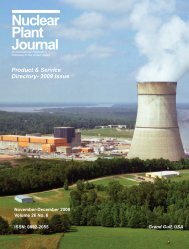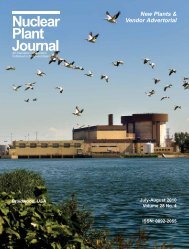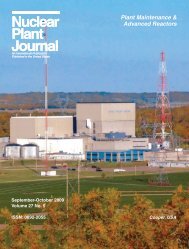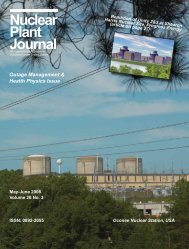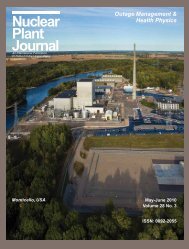Nuclear Plant Journal Outage Management ... - Digital Versions
Nuclear Plant Journal Outage Management ... - Digital Versions
Nuclear Plant Journal Outage Management ... - Digital Versions
Create successful ePaper yourself
Turn your PDF publications into a flip-book with our unique Google optimized e-Paper software.
Exelon, Continuum Dynamics,<br />
Inc. and Structural Integrity Associates<br />
identified MSL locations for 56 strain<br />
gages and 33 accelerometers. The<br />
instruments were strategically placed on<br />
the MSL as input to the acoustic circuit<br />
analysis for steam dryer loading and MSL<br />
vibration evaluations.<br />
In May 2005, Quad Cities unit 2<br />
ramped up in power based on the startup<br />
test plan and collected data from the<br />
sensors on the steam path at the designated<br />
power levels. Data acquisition equipment<br />
was obtained to collect steam dome, steam<br />
dryer and main steam line strain gage,<br />
pressure transducer and accelerometer<br />
data simultaneously. When a power level<br />
was reached, the data were collected and<br />
analyzed based on pre-established go<br />
/ no-go criteria until 2832 MWt; which<br />
was the highest MWt at EPU that could<br />
be reached with the environmental factors<br />
for that time of year.<br />
The data from the instrumented MSLs<br />
and steam dryer revealed the pressure<br />
oscillations at approximately 157 Hz<br />
that dramatically increased in amplitude<br />
above the original licensed thermal power.<br />
These high frequency pressure oscillations<br />
peaked on the dryer surface directly in<br />
front of the main steam line nozzles. This<br />
testing showed that the ERV and MSSV<br />
standpipes at Quad Cities were a probable<br />
cause of the increased loading on not only<br />
the dryer, but also on the entire steam<br />
path.<br />
In December 2005, an electrical<br />
ground was found present on the Quad<br />
Cities unit 2 3D ERV. The subsequent<br />
inspection revealed significant internal<br />
damage to the solenoid actuator. Additional<br />
inspections of the remaining ERVs<br />
for both Quad Cities units show significant<br />
wear and loose parts on the solenoid<br />
actuators. The root cause once again<br />
pointed to high frequency vibration damage.<br />
These valves are safety related components<br />
and are required to operate in the<br />
event of MSL over pressurization.<br />
The probable root cause identification<br />
and the additional ERV damage escalated<br />
the need for a MSL load reduction device.<br />
The starting point for this project was to<br />
assemble a team of industry experts to<br />
brainstorm possible mitigation devices.<br />
The ideas for mitigation ranged from<br />
making Quad Cities ERV and MSSV<br />
standpipes the same diameter as Dresden<br />
to changing the height of the standpipes<br />
as well as several other combinations of<br />
geometry changes.<br />
To ensure the various ideas were<br />
tested appropriately, the team determined<br />
a scale model test program that would be<br />
benchmarked against the in-vessel and<br />
steam path data collected at Quad Cities<br />
was required. To perform this successfully,<br />
the appropriate Reynolds Number<br />
had to be applied correctly throughout<br />
the test rig, otherwise the results would<br />
not reflect actual in-plant data. This presented<br />
a challenge since to achieve the<br />
appropriate Reynolds numbers, the scale<br />
model test had to be at elevated pressures,<br />
making the test rig at full scale very large.<br />
Continuum Dynamics, Inc. (CDI) was<br />
contracted to develop a pressurized test<br />
rig and perform the benchmark to Quad<br />
Cities in-plant data at subscale to avoid<br />
this problem.<br />
With this approach CDI was able to<br />
correctly duplicate the high frequency<br />
response from the Quad Cities main<br />
steam line actual in-plant data with the<br />
scale model test rig. This confirmed the<br />
probable root cause to be from the relief<br />
valve standpipes. Based on domestic and<br />
international benchmarking, this is an<br />
industry first, to take in-plant data from an<br />
instrumented steam path and successfully<br />
benchmark a scale model test rig against<br />
the data.<br />
With the benchmark completed,<br />
hundreds of tests were performed on<br />
numerous mitigation concepts, in addition<br />
to optimizing the acoustic side branch<br />
concept.<br />
In the end the team selected an<br />
acoustic mitigation device that branches<br />
off the valve standpipe side. This option<br />
was chosen for the following reasons:<br />
• The acoustic side branch (ASB)<br />
addition increases the effective length<br />
(L) of the standpipe, decreasing the<br />
acoustic standing wave frequency<br />
(f).<br />
• The vortex shedding frequency<br />
remains unchanged at the same<br />
power level, but the acoustic and<br />
vortex shedding frequencies are no<br />
longer coupled, so that resonance<br />
does not occur.<br />
• The acoustic frequency decrease<br />
lowers the velocity at which vortex<br />
shedding will excite the acoustic<br />
standing wave (i.e. the acoustic<br />
(Continued on page 40)<br />
<strong>Nuclear</strong> <strong>Plant</strong> <strong>Journal</strong>, May-June 2009 www.nuclearplantjournal.com 39



